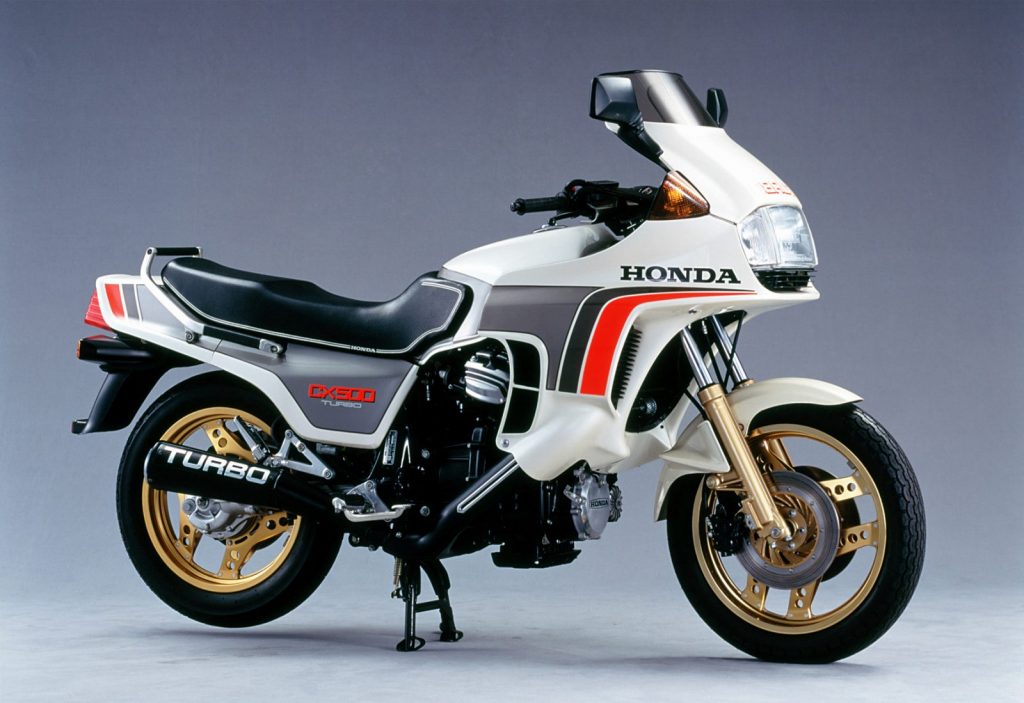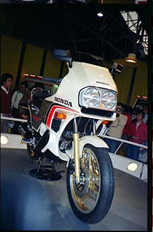For English see below
EEN NIEUW TECHNISCH TIJDPERK

Honda introduceerde in 1981 de CX500 Tc, nog geen jaar nadat een prototype op de IFMA in Keulen te zien was. De eerste productie motor met Turbo aandrijving. Niet alleen een technisch hoogstandje, maar ook een vertoon van ingenieuze Japanse lef. En de introductie van een geheel nieuwe rijervaring die dankzij de Turbo op dat moment zijn weerga niet kende.
Het prototype uit 1980 had nog een dubbele koplamp en zilveren velgen en – remschijven. De definitieve versie was zowel toentertijd als nu, een genot om te zien: knipperlichten en luchtroosters in de kuip weggewerkt, een markante koplamp en een volledig uitgesneden uitlaat. Niet te vergelijken met de tot dan toe ‘gewone’ CX500 Euro waar de Turbo lichtjes op gebaseerd is.
De Honda 500 Tc was en is een technische revolutie. Met 4 MAP sensoren, die op verschillende plaatsen de drukken in het inlaatgedeelte meten, injectie met motormanagement, Pro Link achtervering, antieduik voorvering, en een stijver frame dan de gewone CX. De accenten moesten liggen op het feit dat deze motor een turbo heeft, dat komt niet alleen tot uiting in de rijstijl maar ook visueel met op beide uitlaten TURBO in hoofdletters en op de top van de kuip TURBO in spiegelschrift (OBRUT) als waarschuwing voor het verkeer dat er snelheid aan komt. Het lijnenspel van de kuip wordt geaccentueerd met oranje-rode vanen, om de snelheid van de machine extra te benadrukken.

De Turbo CX500Tc heeft een compressie verhouding van 7,2:1, waarmee het uit het detonatie gebied blijft dat zou kunnen ontstaan bij hoge toeren en onder turbodruk. Een gevolg was onder andere dat de Turbo onderin iets minder kracht heeft, maar juist vanaf 6000 t/m het vermogen er snel inkomt. Hier moet je met name in de bocht op beducht zijn, zeker als beginnende rijder. Gelukkig wennen de bijzondere rijeigenschappen snel genoeg.
Veel van deze techniek werd speciaal voor de Turbo ontwikkeld. Maar liefst 230 nieuwe patenten werden aangevraagd op het ontwerp. Een unicum! Door de enorme ontwikkelingskosten was de machine duur in aanschaf. In het begin was de CX500Tc niet zuinig in gebruik zeker in Europa niet, maar na een terugroepactie waarbij de ECU (computer) vervangen werd was het verbruik een stuk aangenamer (ca. 1:18).
De fabrieksopgave van 82pk bij 8000t/m werd op menige rollerbank oveftroffen en we gaan nu uit van 90-92 pk. Naast benzine verslond de machine in die tijd dus ook veel achterbanden.
De CX500Tc is slechts een jaar geproduceerd en er zijn 5.500 machines van de band gerold. Ondanks dat de machine fantastisch rijdt en technisch goed in elkaar bleek te zitten, was de prijs destijds gewoon te hoog en daarom werd de CX500Tc moeilijk verkocht.
Toch werd met deze CX500Tc de norm gezet. Kawasaki kwam in 1984 met een luchtgekoelde 4 cilinder met 2 sensoren, deze motor was minder complex en sneller. Het leek haast dat Kawasaki de prestigeslag in 1984 ging winnen. Honda liet dat niet over zijn kant gaan en kwam met een geheel vernieuwd concept: de Honda CX 650 Turbo.
Terugkijkend met ca 40 jaar gebruikers ervaring blijkt de machine erg betrouwbaar te zijn. Kilometerstanden van 100000 en meer zijn geen uitzondering. De vrees van velen bij de introductie van de machine dat deze techniek niet betrouwbaar zou zijn was geheel ongegrond. De turbo, een duur onderdeel, gaat zelden of nooit kapot. En de ECU (boordcomputer) lijkt het eeuwige leven te hebben en is voorzien van een Fail-Safe systeem. Dat zorgt er voor dat, mocht er onderweg een component defect raken, er automatisch overgeschakeld wordt naar een veilige modus, zodat de motor toch blijft rijden. En of dat al niet genoeg is heeft Honda er ook een Zelf Diagnose Systeem in opgenomen. De zwakste schakel is de dynamo maar hiervoor is binnen de HFTC een verbeterde versie ontwikkeld.
Kun je er een kopen? DOEN! (en lid worden van deze club)
Honda CX500 Turbo
A NEW TECHNICAL ERA

Honda introduced the CX500 Tc in 1981, less than a year after a prototype was shown at the IFMA in Cologne. The first production engine with Turbo drive. Not only a technical tour de force, but also a display of ingenious Japanese guts. And the introduction of an entirely new driving experience that was unprecedented at the time thanks to the Turbo.
The 1980 prototype still had a twin headlight and silver rims and brake discs. The final version was, then as now, a joy to see: indicators and air vents concealed in the fairing, a distinctive headlamp and a fully-cut exhaust. Not comparable with the hitherto ‘normal’ CX500 Euro on which the Turbo is slightly based.
The Honda 500 Tc was and is a technical revolution. With 4 MAP sensors, which measure the pressures in the intake area in different places, injection with engine management, Pro Link rear suspension, anti-dive front suspension, and a stiffer frame than the regular CX. The accents had to be on the fact that this engine has a turbo, which is not only reflected in the driving style but also visually with TURBO in capital letters on both exhausts and on the top of the fairing TURBO in mirror writing (OBRUT) as a warning for the traffic approaching speed. The cockpit lines are accentuated with orange-red vanes to emphasise the speed of the machine.

The Turbo CX500Tc has a compression ratio of 7.2:1, which keeps it out of the detonation zone that could occur at high revs and under turbo pressure. A consequence was, among other things, that the Turbo at the bottom has slightly less power, but from 6000 to the power comes in quickly. You should be especially wary of this in the bend, especially as a novice rider. Fortunately, the special driving characteristics quickly enough.
Much of this technology was developed especially for the Turbo. No fewer than 230 new patents were applied for on the design. A unique one! Due to the enormous development costs, the machine was expensive to purchase. In the beginning, the CX500Tc was not economical in use, certainly not in Europe, but after a recall in which the ECU (computer) was replaced, consumption was a lot more pleasant (approx. 1:18).
The manufacturer’s specification of 82 hp at 8000 t/m was exceeded on many dynamometer and we now assume 90-92 hp. In addition to gasoline, the machine also devoured a lot of rear tires at that time.
The CX500Tc has only been produced for a year and 5,500 machines have rolled off the production line. Despite the fact that the machine drives fantastically and turned out to be technically well put together, the price was simply too high at the time and therefore the CX500Tc was difficult to sell.
Nevertheless, the standard was set with this CX500Tc. Kawasaki came in 1984 with an air-cooled 4 cylinder with 2 sensors, this engine was less complex and faster. It almost seemed that Kawasaki was going to win the prestige battle in 1984. Honda did not let that pass and came up with a completely renewed concept: the Honda CX 650 Turbo.
Looking back with about 40 years of user experience, the machine appears to be very reliable. Mileage of 100000 and more are no exception. The fears of many when the machine was introduced that this technique would not be reliable was completely unfounded. The turbo, an expensive part, rarely if ever breaks. And the ECU (on-board computer) seems to have eternal life and is equipped with a Fail-Safe system. This ensures that, if a component breaks down on the road, it automatically switches to a safe mode, so that the engine continues to run. And if that isn’t enough, Honda has also included a Self Diagnosis System. The weakest link is the dynamo, but an improved version has been developed for this within the HFTC.
Can you buy one? DO IT! (and join this club)